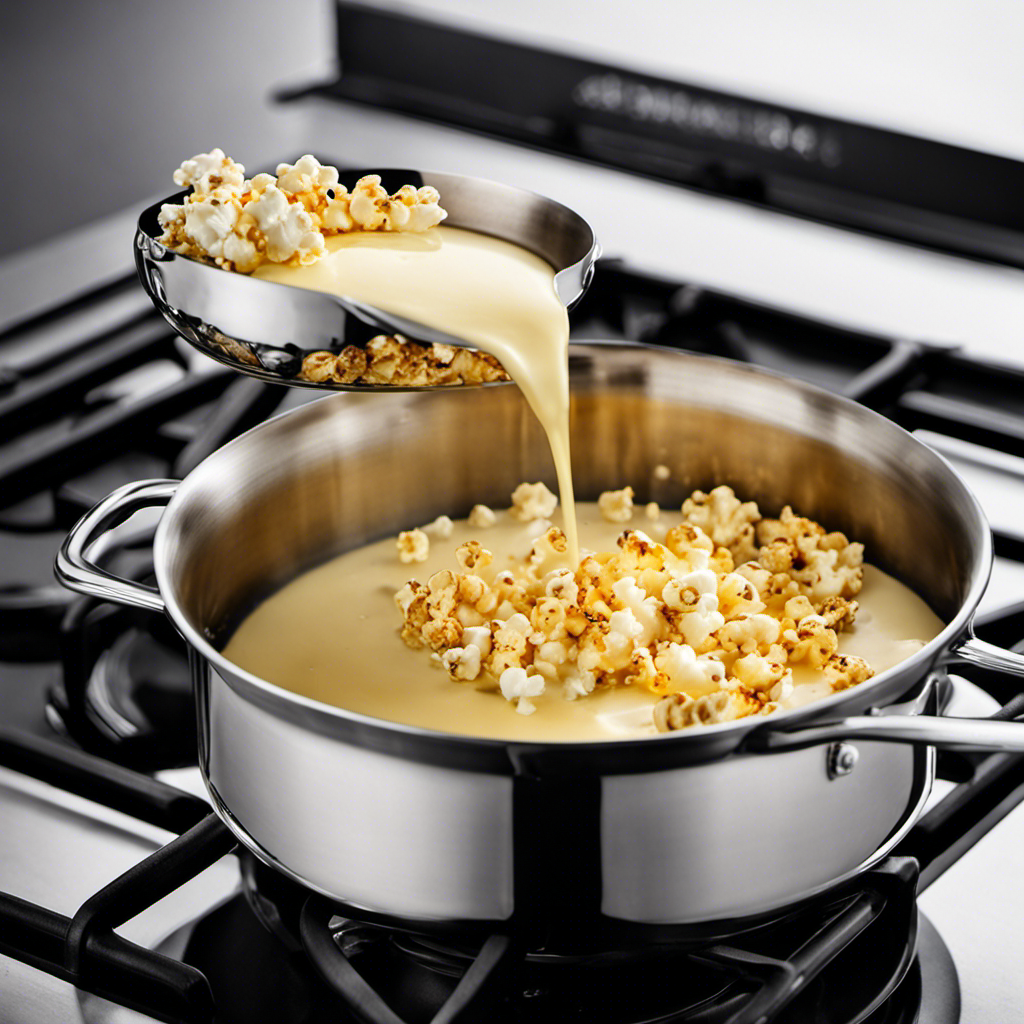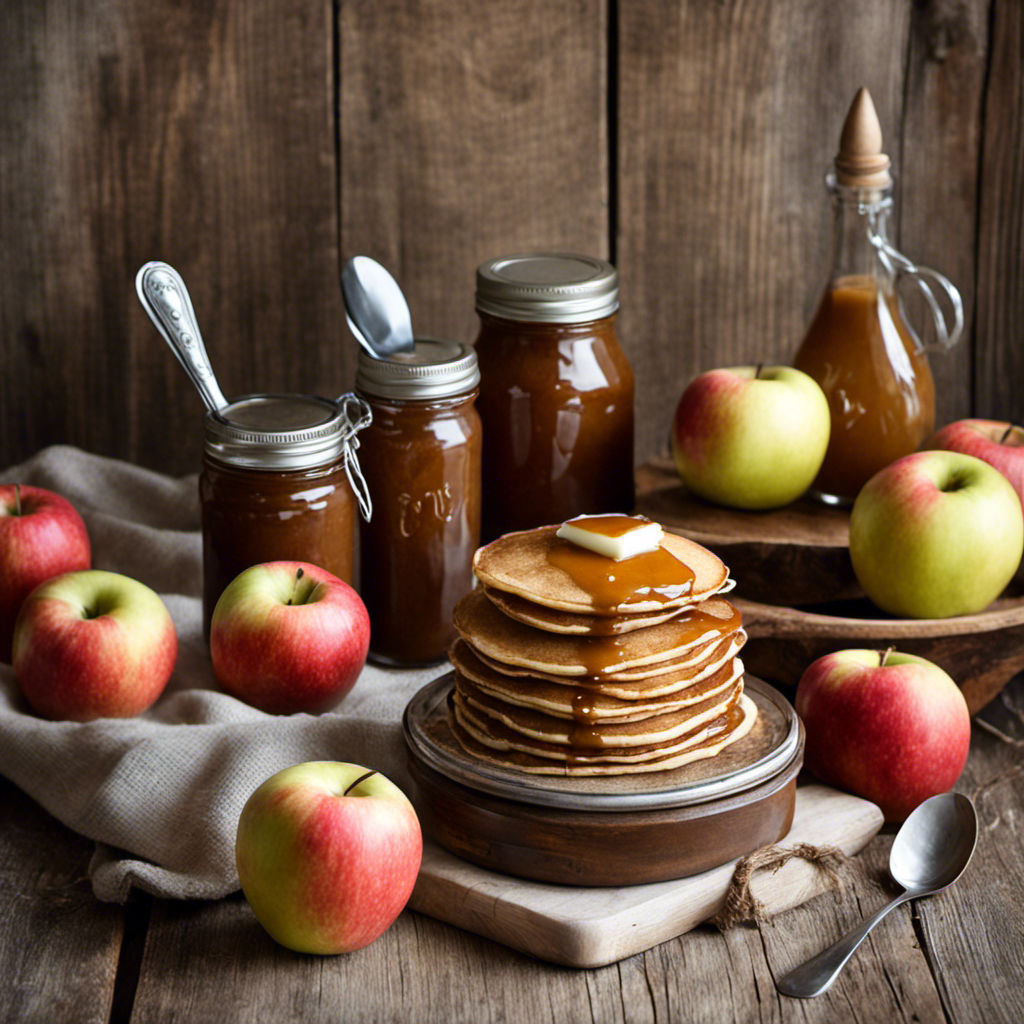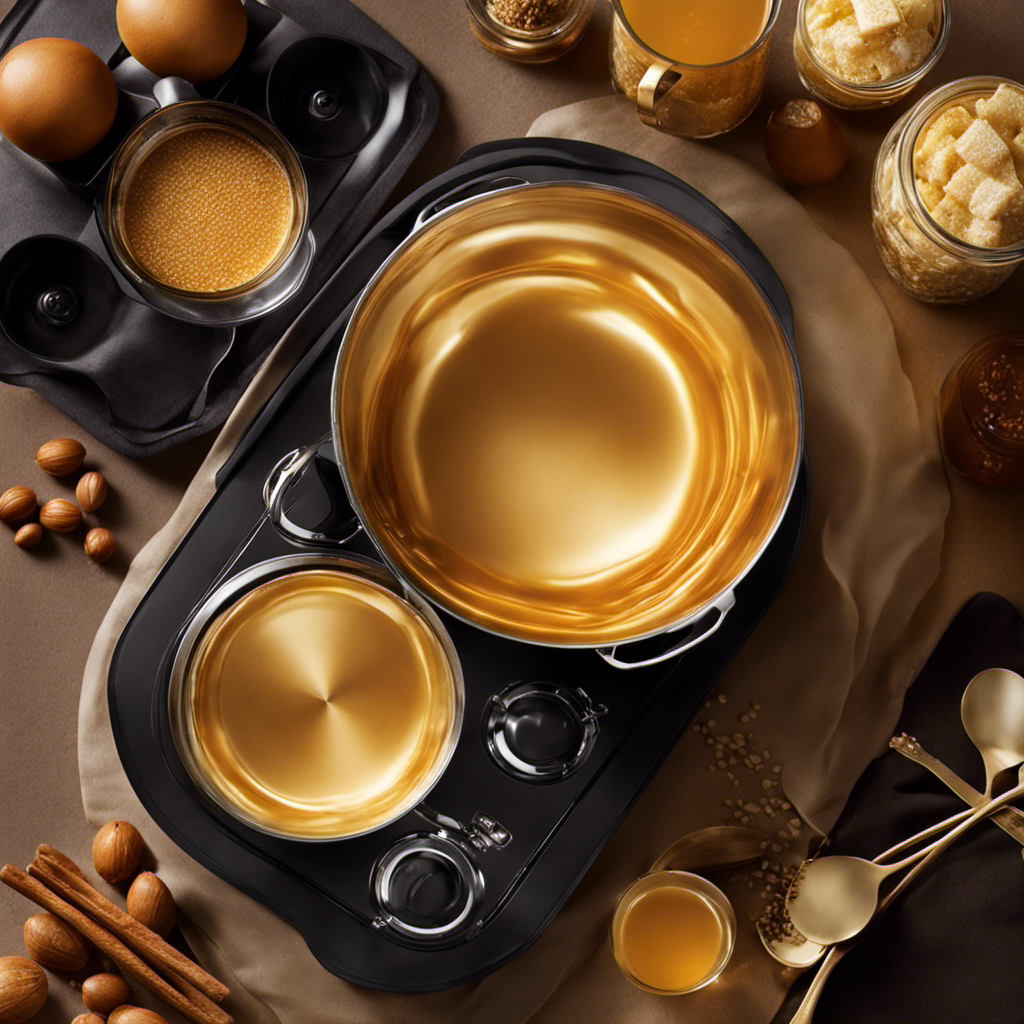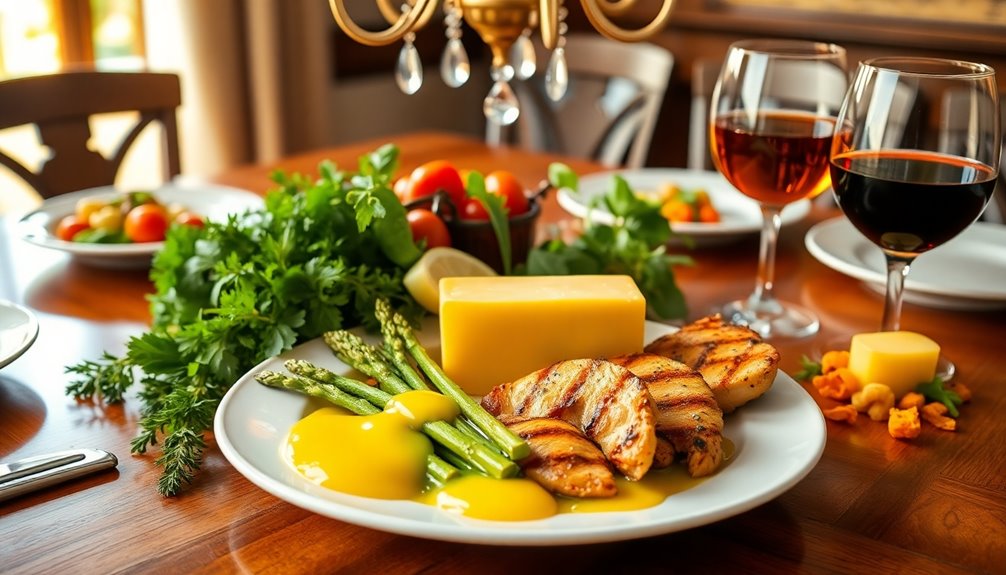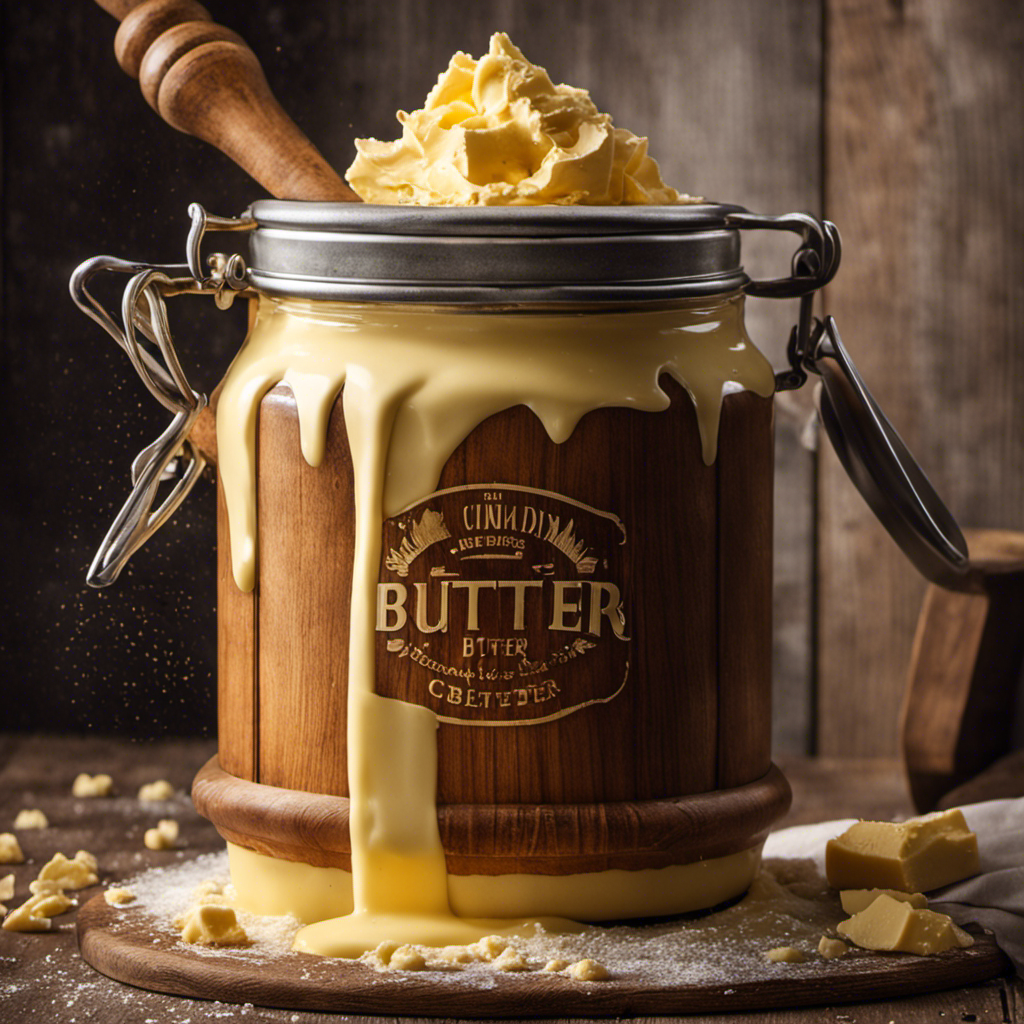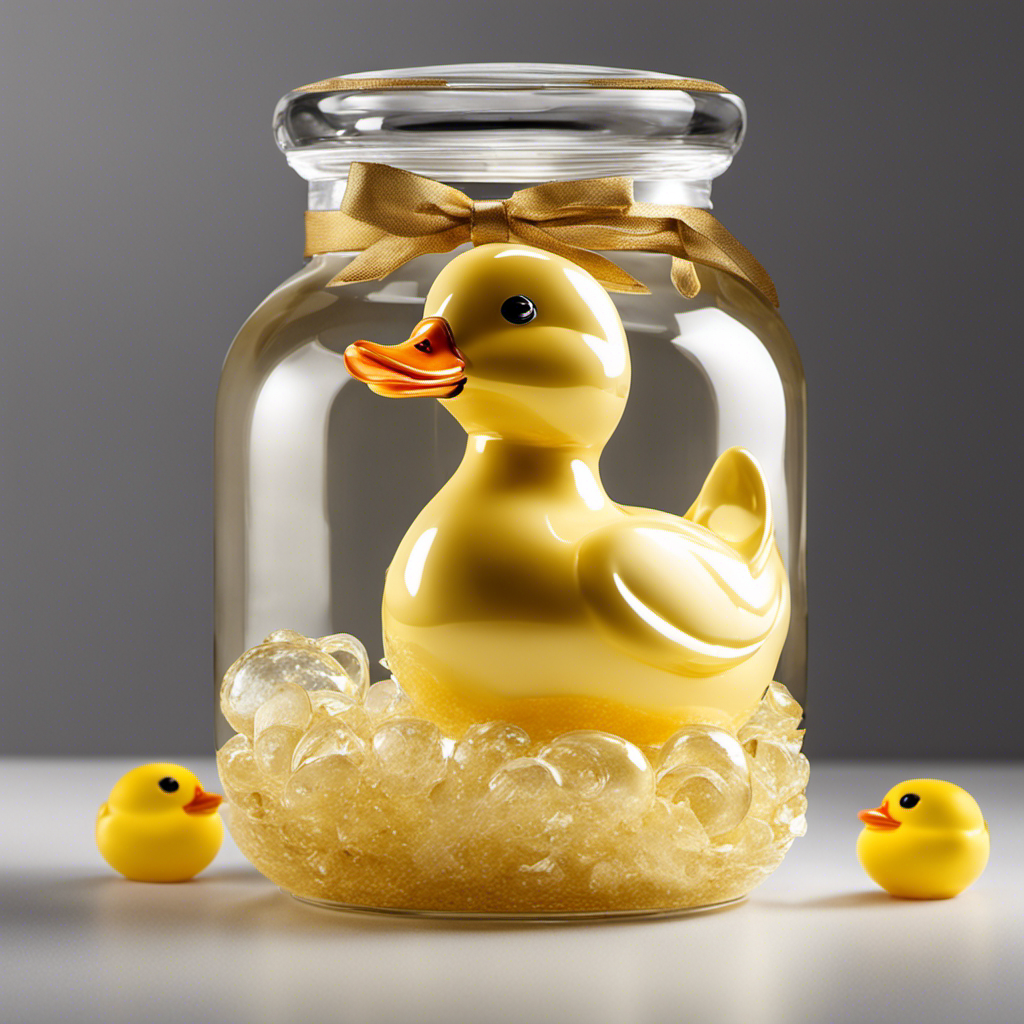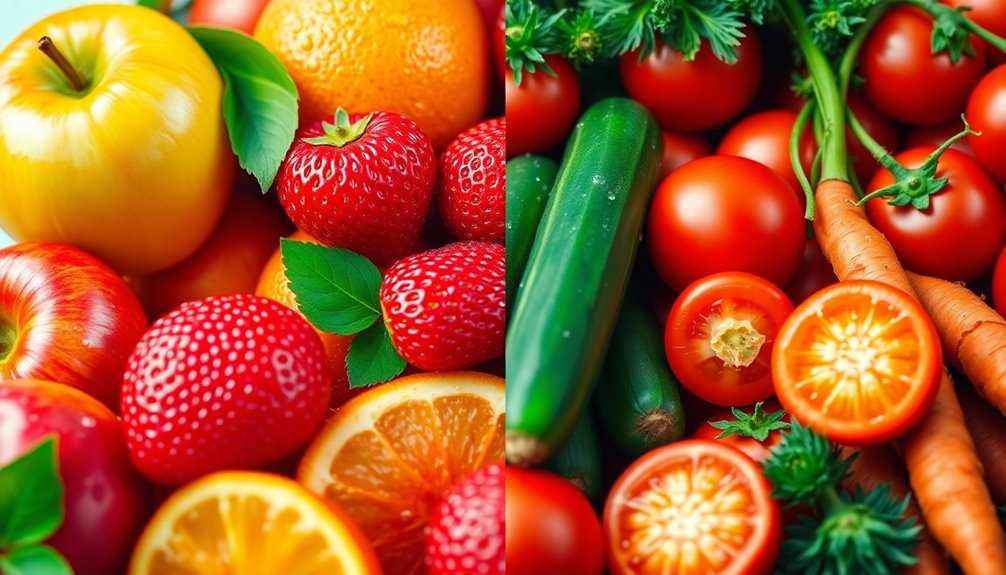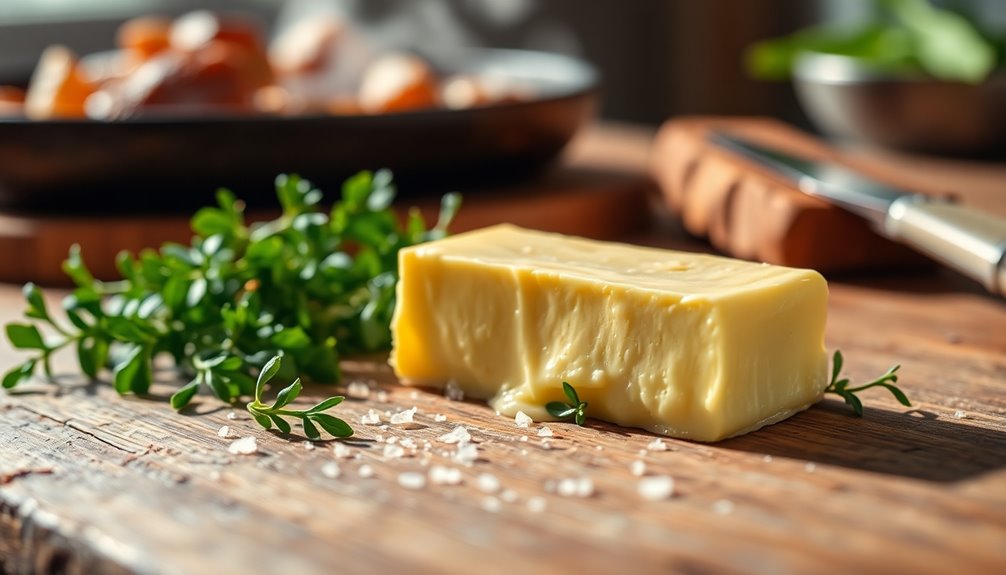Have you ever wondered why the popcorn you make at home just doesn’t compare to theater popcorn? The secret is in the butter.
In this article, I’ll show you the foolproof way to melt butter for popcorn that will take your snack game to the next level. With the right butter, proper preparation, and the best melting method, you’ll achieve that perfect, silky consistency every time.
Get ready to elevate your popcorn experience with this simple yet essential technique.
Key Takeaways
- Consider the flavor and saltiness of the butter for popcorn.
- Choose the best melting method based on preference and timing.
- Oil can be a healthier alternative to butter for popcorn.
- Use caution and follow safety precautions when melting butter in the microwave.
Selecting the Right Butter
When selecting the right butter, it’s important to consider the flavor and saltiness.
The flavor of butter can vary depending on factors like the cow’s diet and the region it comes from. Some butter has a rich, creamy taste, while others have a more subtle flavor.
Saltiness is another factor to consider. Salted butter adds a savory element to dishes, while unsalted butter allows you to control the salt content yourself.
In terms of storage, it’s best to keep butter refrigerated to maintain its freshness and prevent it from spoiling. However, if you prefer a softer spread, you can keep it at room temperature for short periods.
If you’re looking for butter alternatives, options like ghee, margarine, and plant-based spreads are available, each offering their own unique flavors and textures.
Preparing the Butter for Melting
First, you’ll want to gather all the necessary ingredients for getting the butter ready to melt. Here are some tips to help you prepare the butter for melting:
- Choose the right equipment: Ensure you have a microwave-safe bowl or a small saucepan, depending on your preferred method of melting the butter.
- Use unsalted butter: This allows you to control the saltiness of your popcorn. If you prefer a different flavor, you can also try using alternative butter options like ghee or coconut oil.
- Cut the butter into small pieces: This helps it melt evenly and quickly.
- Melt the butter slowly: Whether you’re using a microwave or stovetop, low heat or short bursts in the microwave will prevent the butter from burning.
- Stir the butter occasionally: This ensures that it melts evenly and prevents any clumps from forming.
Choosing the Best Melting Method
When it comes to melting butter for popcorn, there are a few key points to consider: the method of melting, the choice between butter and oil, and the importance of temperature and timing.
The first decision is whether to use a stovetop or a microwave to melt the butter. Both methods have their pros and cons, so it’s important to understand which one suits your needs best.
Additionally, deciding between using butter or oil can greatly impact the flavor and texture of your popcorn.
Lastly, getting the temperature and timing just right is crucial to ensure that your butter melts evenly and doesn’t burn.
Stovetop Vs. Microwave
To melt butter for popcorn, you can use either the stovetop or the microwave. Both methods have their advantages, so it ultimately depends on personal preference and convenience.
Here are some key points to consider:
-
Stovetop Safety: Melt butter in a saucepan over low heat to prevent burning. Stir frequently and keep a close eye on it to avoid accidents.
-
Microwave Convenience: Place the butter in a microwave-safe dish and heat it in short bursts, checking and stirring in between. This method is quick and easy, perfect for those in a hurry.
-
Even Melting: Whichever method you choose, ensure the butter is evenly melted to distribute the flavor evenly over the popcorn.
-
Temperature Control: With the stovetop method, you have more control over the temperature, allowing you to adjust it as needed. In contrast, the microwave may heat the butter unevenly.
-
Clean-up: Microwaving butter leads to fewer dishes to wash, making it a convenient option for those who value simplicity.
Overall, both the stovetop and microwave methods are effective for melting butter for popcorn, so choose the one that suits your preferences and circumstances best.
Butter Vs. Oil
If you’re looking for a healthier option, oil can be a suitable alternative to butter for your popcorn. While butter has its own unique flavor, using oil can provide various health benefits. Here is a comparison between butter and oil as popcorn toppings:
| Butter | Oil | |
|---|---|---|
| Calories | High | Varies depending on the type |
| Saturated Fat | High | Varies depending on the type |
| Cholesterol | Yes | No |
| Health Benefits | None | Contains essential fatty acids |
As you can see, oil can be a better option if you’re watching your calorie and saturated fat intake. Additionally, certain oils like olive oil and coconut oil contain essential fatty acids that are beneficial for your health. Transitioning to the next section, let’s now discuss the importance of temperature and timing when melting butter or heating oil for your popcorn.
Temperature and Timing
For optimal results, it’s important to heat the oil or melt the butter at the right temperature and for the appropriate amount of time. Temperature control plays a crucial role in achieving the perfect butter flavor for your popcorn. Here are some tips to help you enjoy a delicious popcorn experience:
- Use a medium heat setting on your stovetop to avoid burning the butter.
- Keep an eye on the butter as it melts to prevent it from getting too hot.
- Stir the butter occasionally to ensure even heating and prevent any scorching.
- Once the butter is fully melted, remove it from the heat source to avoid overcooking.
- Allow the melted butter to cool slightly before drizzling it over your popcorn for the best flavor distribution.
Now that we’ve covered temperature and timing, let’s move on to the next section about melting butter on the stovetop.
Melting Butter on the Stovetop
Place the butter in a saucepan and melt it over low heat. When it comes to melting butter for popcorn, it is crucial to choose the right substitute if you have dietary restrictions or simply want to try something different. There are various alternatives to butter that can provide a similar taste and texture, such as coconut oil, olive oil, or even ghee. Experimenting with different options can add a unique flavor profile to your popcorn. Additionally, if you don’t have a stovetop available, there are alternative melting methods you can try. One option is to melt the butter in the microwave by placing it in a microwave-safe bowl and heating it in short intervals until fully melted. Another option is to use a double boiler, which involves placing the butter in a heatproof bowl over a pot of simmering water. Whichever method you choose, make sure to melt the butter slowly and evenly to avoid burning it and ruining the taste of your popcorn.
Table:
| Butter Substitute | Key Features |
|---|---|
| Coconut oil | Adds a subtle tropical flavor |
| Olive oil | Provides a rich and savory taste |
| Ghee | Offers a nutty and buttery flavor |
| Margarine | A non-dairy alternative |
Melting Butter in the Microwave
When it comes to melting butter in the microwave, there are a few key points to keep in mind.
First, the microwave melting time can vary depending on the amount of butter and the power of your microwave. It’s important to start with shorter intervals and check the butter frequently to avoid over-melting or splattering.
Additionally, using proper butter melting techniques such as cutting the butter into smaller pieces or using a microwave-safe container can help ensure even melting.
Lastly, it’s crucial to follow safety precautions when microwaving butter. This includes using microwave-safe containers, covering the butter to prevent splattering, and being cautious when handling hot melted butter.
Microwave Melting Time
To achieve the perfect consistency, you should microwave the butter for short bursts of time, making sure to stir in between. This technique allows for even melting and prevents the butter from splattering.
Here are some tips to help you melt butter in the microwave effectively:
- Start by placing the desired amount of butter in a microwave-safe bowl.
- Set the microwave power to medium or 50% to avoid overheating the butter.
- Microwave the butter for 15-20 seconds at a time.
- After each interval, take the bowl out and give the butter a quick stir.
- Continue microwaving and stirring until the butter is completely melted.
By following these microwave power settings and stirring in between, you can ensure that the butter melts evenly and doesn’t splatter.
Now, let’s move on to the next section about other butter melting techniques.
Butter Melting Techniques
For the best results, simply follow these techniques when melting your butter in the microwave.
There are a few butter melting hacks that can help you achieve perfectly melted butter every time.
One alternative method is to cut the butter into small pieces and place them in a microwave-safe bowl. Then, microwave the butter on low power for 10-second intervals, stirring in between each interval until the butter is completely melted.
Another method is to use a microwave-safe measuring cup and melt the butter in 30-second increments, stirring after each interval. This ensures even melting without any hot spots.
Remember to cover the butter with a microwave-safe lid or paper towel to prevent splattering.
With these alternative butter melting methods, you’ll have perfectly melted butter for your popcorn or any other recipe in no time.
Safety Precautions When Microwaving
To ensure your safety when using the microwave, it’s important to follow these precautions:
- Always use microwave-safe containers to melt butter.
- Use microwave-safe covers or lids to prevent splattering.
- Avoid using metal containers or utensils in the microwave.
- Never leave the microwave unattended while melting butter.
- Allow the melted butter to cool before removing it from the microwave.
Microwave safety is crucial to prevent accidents and ensure a smooth cooking experience. By following these precautions, you can enjoy the convenience of melting butter in the microwave without any risks.
Now that we’ve covered the safety aspect, let’s move on to the next section where I will share some tips for perfectly melted butter.
Tips for Perfectly Melted Butter
If you want perfectly melted butter for your popcorn, make sure to use a microwave-safe bowl. This will ensure that your butter gets heated evenly and doesn’t splatter all over the microwave.
When it comes to achieving the perfect popcorn, using butter alternatives can be a great option. One popular alternative is clarified butter, also known as ghee. It has a rich and nutty flavor that complements the popcorn well.
Another option is coconut oil, which adds a slightly sweet and tropical taste. For a healthier alternative, you can try using olive oil or avocado oil. These oils are heart-healthy and can give your popcorn a delicious flavor.
Frequently Asked Questions
Can I Use Margarine Instead of Butter for Melting on Popcorn?
Yes, you can use margarine instead of butter for melting on popcorn. However, keep in mind that margarine may have a different flavor and texture. Additionally, using flavored butter can add a delicious twist to your popcorn.
How Long Does It Take to Melt Butter on the Stovetop?
To melt butter quickly on the stovetop, I recommend using a low heat setting and constantly stirring until fully melted. If you’re looking for alternative melting methods, you can also use a microwave or a double boiler.
Can I Melt Butter in the Microwave Without a Microwave-Safe Container?
Sure, melting butter without a microwave-safe container can be risky. However, one alternative method is using a double boiler. Place a heatproof bowl over a pot of simmering water, stirring the butter until melted.
How Do I Prevent the Melted Butter From Solidifying Too Quickly?
To prevent the melted butter from solidifying too quickly and maintain its consistency, I recommend using a low heat setting when melting it. This will ensure a smooth and liquid consistency for your popcorn.
Is There a Specific Type of Popcorn That Pairs Best With Melted Butter?
When it comes to pairing butter with popcorn, there isn’t a specific type that reigns supreme. It’s all about personal preference. However, for the best seasoning, try adding some salt or a sprinkle of cheese. As for alternative toppings, consider caramel or chocolate drizzle.
Conclusion
In conclusion, melting butter for popcorn doesn’t have to be a daunting task. By selecting the right butter, preparing it properly, and choosing the best melting method, you can achieve that perfect, velvety consistency.
Whether you prefer the stovetop or the microwave, following these tips will ensure your butter is melted to perfection every time. So next time you settle in for a movie night, impress your friends with your knowledge and skill in the art of melting butter.
It’s like creating a cinematic masterpiece for your taste buds.
